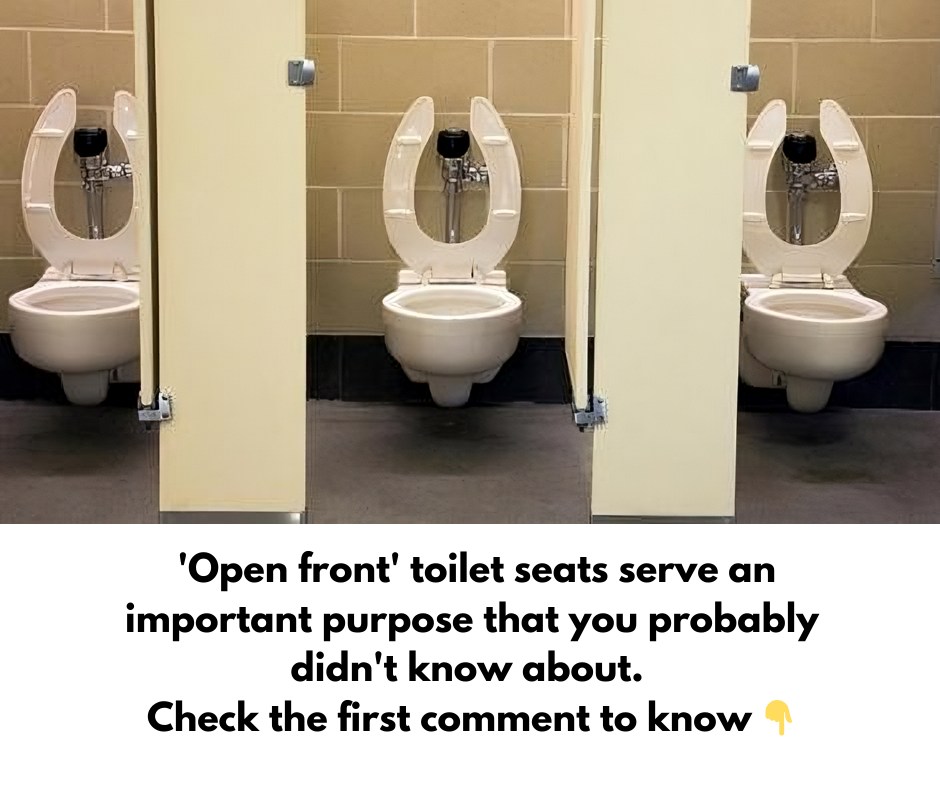Have you ever noticed that public restrooms often have U-shaped toilet seats instead of the fully circular ones commonly found in homes? It might seem like a small difference, but this unique design actually serves a critical purpose. While there are plenty of theories about why public toilet seats have this open-front style, the real reason is surprisingly practical. In fact, understanding this design choice could change the way you think about public restrooms entirely.

The Mystery Behind U-Shaped Toilet Seats
At first glance, the open-front seat design might seem trivial, but it has raised a lot of curiosity. Some people believe the U-shape is primarily for hygiene, while others think it accommodates different body types. There’s even speculation that it helps protect the toilet itself by directing urine away from the seat.
So, what’s the real reason? The answer is both practical and rooted in health and safety standards. As it turns out, the open-front seat is designed to reduce the risk of contamination and improve hygiene in public restrooms.
A Hygienic Design with Purpose
The primary purpose of the open-front toilet seat is to minimize contact with bodily fluids. Hugo Aguilar, Senior Vice President of Codes and Standards at The International Association of Plumbing and Mechanical Officials (IAPMO), explains, “Open-front seats in public restrooms reduce the risk of users coming into contact with possible contamination from previous users.” By leaving a gap at the front of the seat, it becomes easier to avoid contact with urine or other residues that may be left behind.
Additionally, the open design allows for easier cleaning and better access to the seat’s surface, a crucial feature in busy public restrooms where thorough cleaning might not always be possible. The open-front style also helps users avoid touching the areas most likely to be contaminated.
A Practical Solution for Women’s Health
Beyond general hygiene, the U-shaped seat also addresses women’s specific needs. The American Society of Plumbing Engineers explains that the open-front seat was designed with women’s hygiene in mind. The gap allows women to wipe without their hands or tissues brushing against the seat. This small but significant design change adds an extra level of cleanliness and comfort for female users.
Health expert Dr. Poonam Desai also points out that many women hover over the toilet seat in public restrooms to avoid sitting on it, which can strain pelvic muscles. This strain can lead to incomplete bladder emptying, increasing the risk of urinary tract infections (UTIs). The open-front seat encourages sitting, reducing strain and promoting healthier bathroom habits.
Code Requirements for Public Restrooms
Interestingly, the U-shaped toilet seat isn’t just a matter of preference—it’s often required by law. The Uniform Plumbing Code, managed by IAPMO, mandates that public restrooms must use open-front toilet seats or provide automatic seat cover dispensers. This regulation ensures that public restrooms meet a basic level of hygiene and safety for users. While not every state enforces this regulation, the U-shaped seat has become a standard feature in public restrooms across much of the U.S.
How Open-Front Seats Improve Public Hygiene
Let’s be honest: public restrooms don’t have the cleanest reputation. They are often seen as germ hotspots, and some lack basic amenities like soap or toilet paper, which can discourage people from using them. The open-front toilet seat helps mitigate some of these hygiene issues by minimizing direct contact with contaminated surfaces.
When users sit on a closed, circular seat, there’s a higher chance of coming into contact with residue left by previous users. The open-front design reduces this risk, making the experience less unpleasant and decreasing the chances of spreading germs.
Why Sitting is Better Than Hovering
When faced with a less-than-clean public restroom, many people prefer to hover over the seat rather than sit on it. However, as Dr. Desai explains, hovering can do more harm than good. Hovering over the seat can strain pelvic muscles, leading to incomplete bladder emptying, which increases the risk of UTIs.
Instead, Dr. Desai recommends wiping the seat or using a disposable toilet seat cover, which allows users to sit comfortably. Sitting also reduces the likelihood of splashing, helping keep the restroom cleaner for the next person. The open-front seat supports seated use, promoting better personal health and overall restroom cleanliness.
A Small Design with Big Benefits
While the U-shaped toilet seat may seem like a small innovation, it addresses several important issues in public restrooms. It allows for easier wiping, reduces direct contact with potentially contaminated surfaces, and encourages seated use, which improves hygiene and user safety. As a bonus, it’s easier for cleaning staff to maintain, ensuring better sanitation in high-traffic areas.
When you consider all these benefits, it’s clear that the open-front toilet seat serves a valuable purpose beyond aesthetics. While it may not solve every hygiene problem associated with public restrooms, it plays a crucial role in minimizing risks and promoting better practices for all users.
Conclusion: The Open-Front Toilet Seat’s Role in Public Health
Although it may seem like a minor feature, the open-front toilet seat is a thoughtful solution to a common public restroom issue. It promotes hygiene, reduces contact with contaminants, and improves the overall experience of using public restrooms. The next time you encounter one of these U-shaped seats, remember that it’s designed to make your restroom experience a little cleaner and safer.
In the end, this humble design choice is a small but significant step toward better public health. Whether you’re at a gas station, airport, or restaurant, you can take comfort in knowing that even the smallest details, like the shape of a toilet seat, have been considered to improve hygiene and safety.





